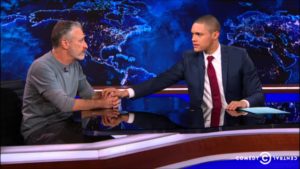No words quite come close to bringing so much dread to an audience as the words reboot and remake. Movies like Harald Zwart’s The Karate Kid (2010) and Len Wiseman’sTotal Recall (2012) have put a sour taste in people’s mouth. These movies completely missed what made the originals so beloved. Instead of focusing on plot and characters, these reboots rely on flashy CGI and a plot which fans will remember. This reliance on the fans loyalty to the originals is what studios bank on, sacrificing effort for the title of a movie that succeeded in the past.

No words quite come close to bringing so much dread to an audience as the words reboot and remake. Movies like Harald Zwart’s The Karate Kid (2010) and Len Wiseman’s Total Recall (2012) have put a sour taste in people’s mouth. These movies completely missed what made the originals so beloved. Instead of focusing on plot and characters, these reboots rely on flashy CGI and a plot which fans will remember. This reliance on the fans loyalty to the originals is what studios bank on, sacrificing effort for the title of a movie that succeeded in the past.
CGI and new actors aren’t what make good remakes good, take John Carpenter’s The Thing (1982), a remake of Howard Hanks’ 1951 film The Thing from Another World. The latter involves a U.S. army team going to the north pole to investigate a UFO, while the former involves a research team stumbling upon a dog who turns out to be an alien. Their plots are incredibly different, the only similarities are in location and basic premise. For instance John Carpenter used a shape-shifting hidden creature and Howard Hanks has a Frankenstein’s monster-esque villain. The reason this remake was made was not to cash in on fans of the original, instead John Carpenter saw the original and thought he could do it better and different. That is what makes a good remake, not copying the original, but using the original as a first draft for a better movie.
Enter Jon Favreau’s The Jungle Book (2016). This movie came out amidst a lot of hatred for reboots with the Ghostbusters reboot trailer being bashed by audiences and with the legacies of movies such as Louis Leterrier’s Clash of the Titans (2010) and Samuel Bayer’s A Nightmare on Elm Street (2010) ruining the reputation of reboots. Audiences were not expecting much from Jon Favreau. However The Jungle Book shattered expectations and set a new bar for the reboot franchise. Not only is the cinematography and casting amazing, with CGI that looks photorealistic and superstars such as Bill Murray, Scarlett Johansson, Idris Elba and Ben Kingsley lending their voices to the cause, this movie also does what The Thing (1982) did 30 years prior. It uses the original movie as a stepping stone to catapult itself to new heights. Jon Favreau saw how outdated and aged Rudyard Kipling’s Jungle Book is, with poor animations and racist themes. The new script is faster and propels the story well beyond Rudyard Kipling’s vignette style narrative. And it removes the racist caricatures of the original that were acceptable at the time of the original’s release. It is both a joy for adults and kids alike and outclasses its older counterpart the same way the rough draft is overshadowed by the final work. This is the new standard in reboots and will most certainly be the movie shown to children when they are told to go watch “The Jungle Book.” It is so good it has rendered the older version obsolete.
The new movie poster for Jon Favreau’s The Jungle Book
photo courtesy of Youtube user World
CGI and new actors aren’t what make good remakes good, take John Carpenter’s The Thing (1982), a remake of Howard Hanks’ 1951 film The Thing from Another World. The latter involves a U.S. army team going to the north pole to investigate a UFO, while the former involves a research team stumbling upon a dog who turns out to be an alien. Their plots are incredibly different, the only similarities are in location and basic premise. For instance John Carpenter used a shape-shifting hidden creature and Howard Hanks has a Frankenstein’s monster-esque villain. The reason this remake was made was not to cash in on fans of the original, instead John Carpenter saw the original and thought he could do it better and different. That is what makes a good remake, not copying the original, but using the original as a first draft for a better movie.
Enter Jon Favreau’s The Jungle Book (2016). This movie came out amidst a lot of hatred for reboots with the Ghostbusters reboot trailer being bashed by audiences and with the legacies of movies such as Louis Leterrier’s Clash of the Titans (2010) and Samuel Bayer’s A Nightmare on Elm Street (2010) ruining the reputation of reboots. Audiences were not expecting much from Jon Favreau. However The Jungle Book shattered expectations and set a new bar for the reboot franchise. Not only is the cinematography and casting amazing, with CGI that looks photorealistic and superstars such as Bill Murray, Scarlett Johansson, Idris Elba and Ben Kingsley lending their voices to the cause, this movie also does what The Thing (1982) did 30 years prior. It uses the original movie as a stepping stone to catapult itself to new heights. Jon Favreau saw how outdated and aged Rudyard Kipling’s Jungle Book is, with poor animations and racist themes. The new script is faster and propels the story well beyond Rudyard Kipling’s vignette style narrative. And it removes the racist caricatures of the original that were acceptable at the time of the original’s release. It is both a joy for adults and kids alike and outclasses its older counterpart the same way the rough draft is overshadowed by the final work. This is the new standard in reboots and will most certainly be the movie shown to children when they are told to go watch “The Jungle Book.” It is so good it has rendered the older version obsolete.







